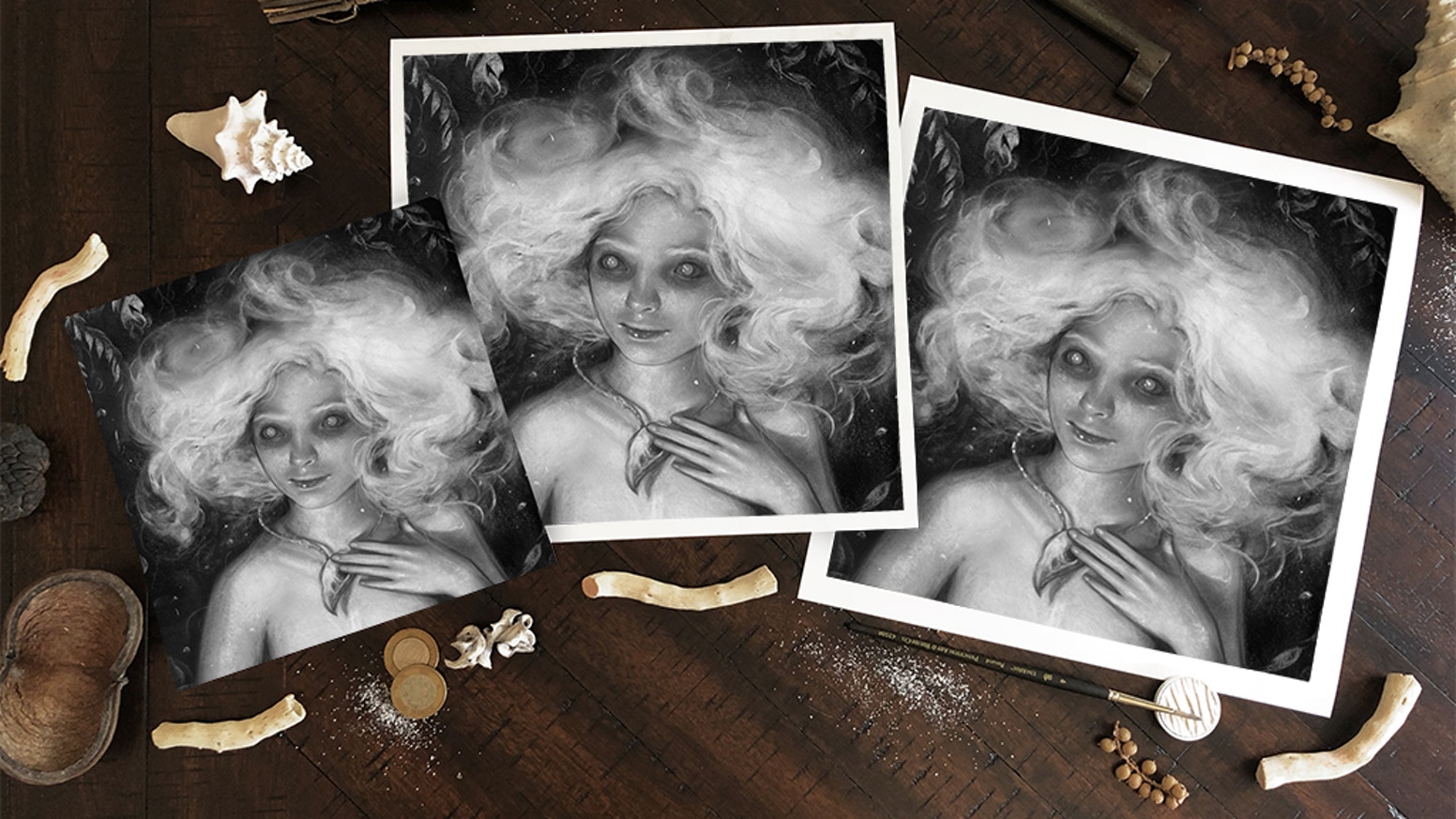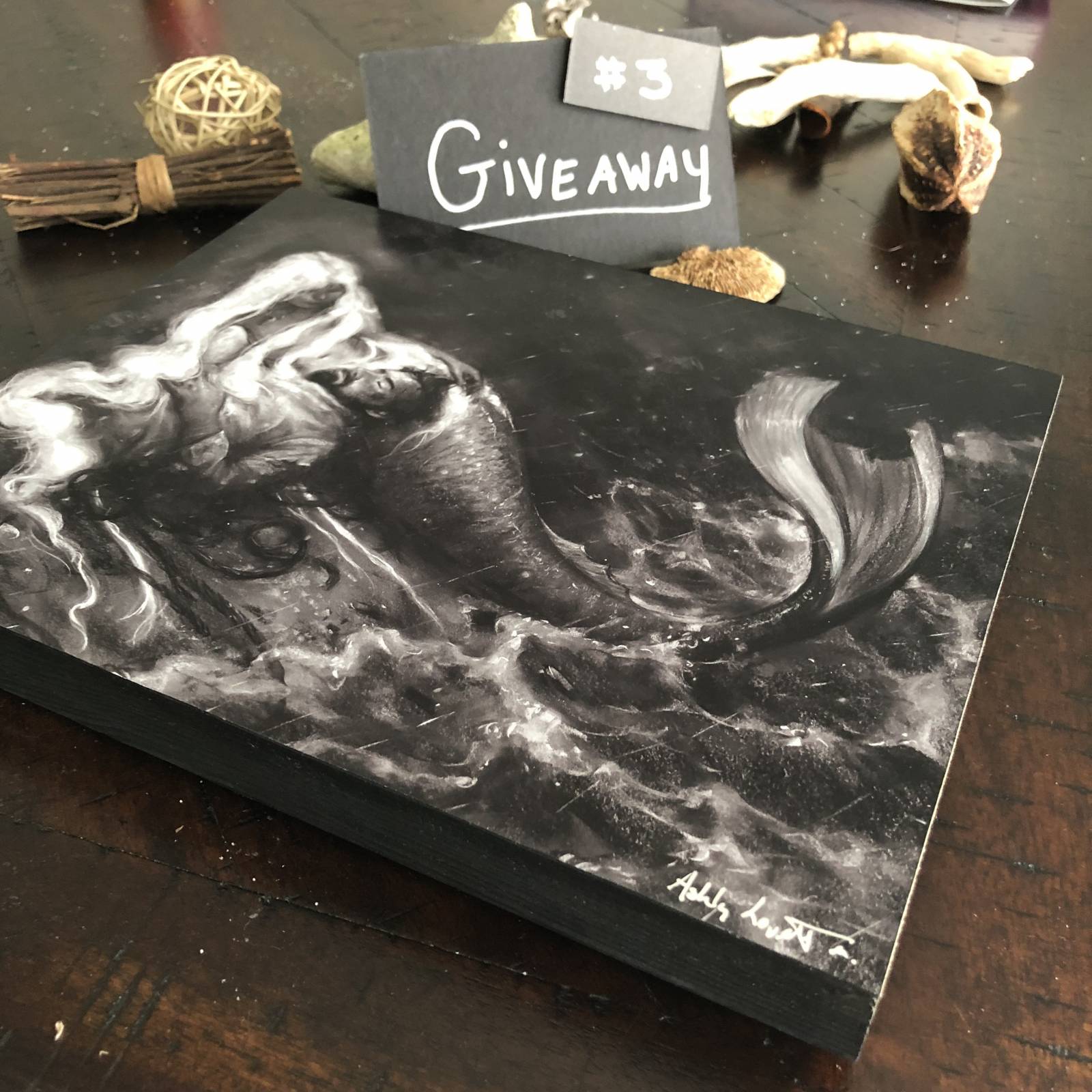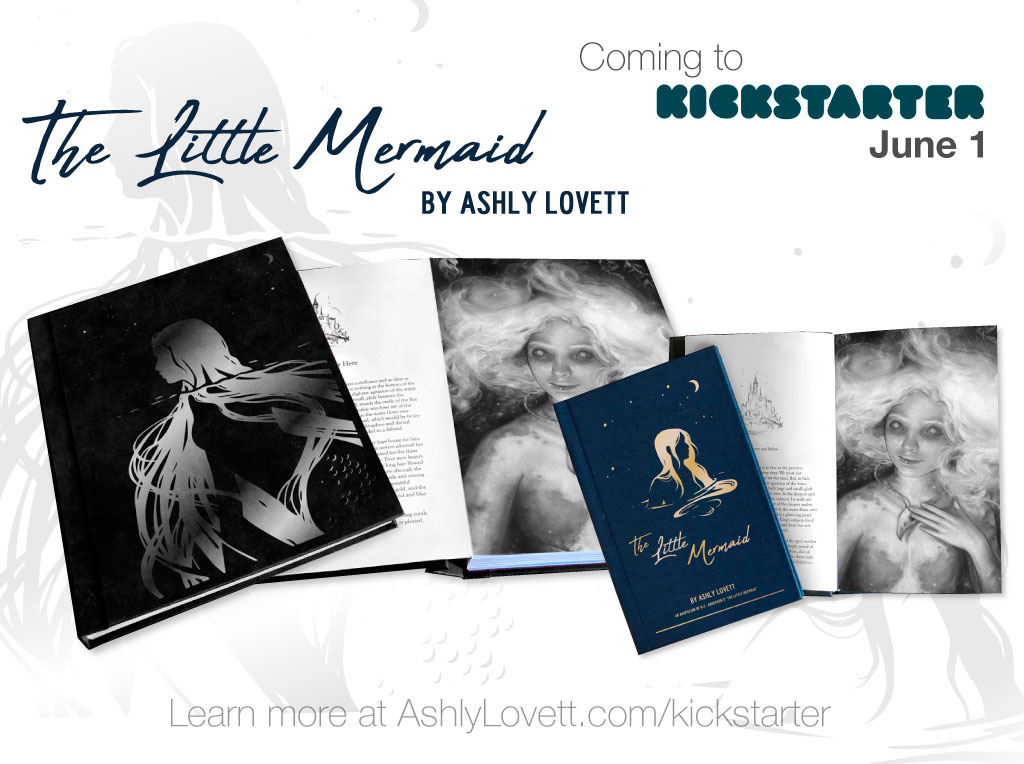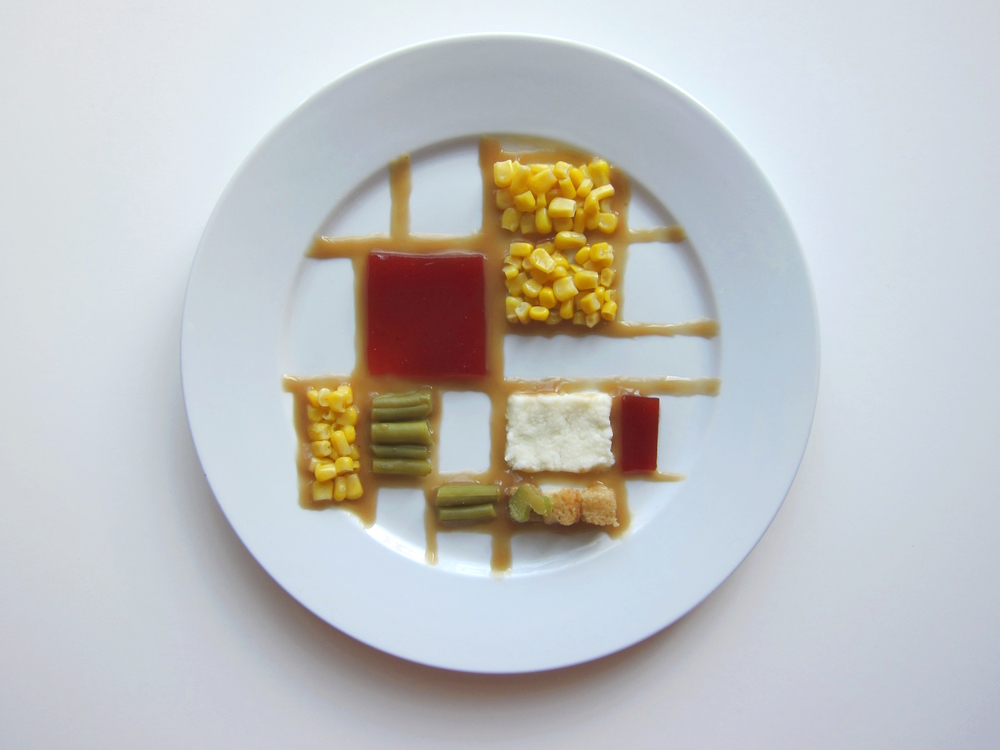Checklist for a Successful Kickstarter
Guest Post by Ashly Lovett
I recently illustrated a “The Little Mermaid” book that is fully funded on Kickstarter right now. I’m here to tell you how I made it happen.
How I Chose my Kickstarter Project
Back in 2017, I made a goal list. Actually, it was after I read this article by Lauren Panepinto. And on my list, I wrote, “Start a long term project and put it on Kickstarter.” Now, what to do? How do you choose something to dedicate a whole year to? For me, I knew that I wanted something that would push me out of my comfort zone. I had been doing my portrait work and loving it. But it was my comfort zone. I needed to pursue something that would broaden my portfolio. I wanted to do more narrative scenes. I wanted tell a story. And that’s when I remembered I had a folder buried on my computer marked “Little Mermaid.”
It was a story I considered when building a children’s book portfolio a long time ago. I decided against it because the old 1830s story was very dark. Not a good fit at the time. But with my current portfolio, it was perfect.
Playing to Your Strengths
“The Little Mermaid” story could easily play to my strengths. My work is organic, which is wonderful for underwater scenes and flowing hair. My strengths lie in my understanding of values. With the darker compositions deep in the ocean, I can push and pull my subjects beautifully. So many opportunities for implied shapes and fun mark-making. Why not have their hair glow? Bioluminescent hair to help guide them as they navigate the sea. I’ve always had a way with my chalk pastels to achieve luminous, ethereal effects. Let’s showcase it.
Now, the challenge of this project, the scary aspect, would be that I’ve never tried to work so small with chalk pastels. But, I found success. I learned new ways of working with my medium. The decision to take on this personal labor of love has been gratifying.
Know Your Audience
You don’t have to choose a project the same way I did. You need to choose something that you’ll be passionate about. And that passion will show in the final product. Be honest about your portfolio and what you bring to the table. Ask yourself, where does your work fit in the market? Could it have mass appeal? Or is it for a niche market? As soon as you know who your work appeals to, the easier it’ll be to network and get the word out about your KS.
How To Prepare
Start Small
I took the advice of fellow creatives and did a small Kickstarter first. I made sure it was related to the long term project, “The Little Mermaid” illustrated book. This way, I could begin building an audience who would be interested in what I was offering. My first KS was a limited edition giclee print run of one of the first illustrations for the book. I had a small funding goal of $700. I learned a lot. I learned how much time it took to build the campaign, how to navigate the Kickstarter website, how best to record an intro video, budget everything, estimate shipping, how exhausting shipping is, etc. I highly suggest doing something small first. It could be a print run, an enamel pin, a softcover sketchbook, etc.
Build an Audience
Decide on a Launch Date
As soon as possible decide when the project will launch. I knew I wanted to aim for June so that I could take advantage of May and the hashtag #MerMay.
Landing Page
I made a landing page on my website that summarized the project and when it would launch. It includes photos, work-in-progress shots, and more.
Quarterly Newsletter (Mailchimp)
I made a Little Mermaid Kickstarter Newsletter that I sent out every 2-4 months. It included process images and design notes as I developed my book and ideas.
Patreon
I started doing demos and sharing process work on my Patreon. I would invite people to join so they can follow my progress.
Conventions
Every convention I talked to people about my project and asked for advice. I handed out postcards that featured artwork from the book. It always included my launch date and landing page address. Nothing pushes you forward more than telling people you’ll do it. It makes you feel more accountable. And on a related note, a lot of people I talk to ended up pledging.
Hashtag
Set up your own hashtag for the project. Mine is #LovettMermaid. You can use it on Tumblr, Twitter, IG, and Facebook. This way, you can direct people to more artwork samples easily. Keep it simple and easy to remember.
Research Social Media
It’s never too early to start researching groups online who would be interested in your project. This would be Facebook groups, Tumblr pages, Reddit pages, DeviantArt, etc. Places you can share your project throughout the year. And posting the occasional BoredPanda article isn’t a bad idea either.
Link Back to the Landing Page
Remember to always refer back to that landing page. It’s your home base.
Self-Discipline
The one thing they don’t tell you about freelancing is that half the battle is staying vigilant and self-discipline. It can be especially tricky when working on a personal project. But, you must set yourself to the task. That’s where the Newsletter and Patreon can help nudge you throughout the year. Get a weekly planner and map out how you’re going to complete your project. I happen to love Moleskins planners. And I have to suggest Drawn and Drafted‘s resources for helping with self-discipline.
3 Months Before Launch (excel sheets all around!)
If you don’t know how to do an excel sheet or hate doing them, you may not want to run Kickstarter by yourself.
Finding Your Manufacture
Do this ASAP. This way, you can start building your funding goal. And you want plenty of time to look at sample products. Weed out the options that are too expensive or too cheap. And you’ll know if you going to work with that company based on their customer service.
Research
Time to start researching. You’ll want to see what similar Kickstarters have been launched, what their funding goals were, what their rewards were, stretch goals, etc. This will help you decide how to build your campaign. Be realistic with your funding goal.
Setting Your Funding Goal
When building your excel sheet budget, stick with the worst case scenario budget. You don’t want to pay out of pocket over a budget mistake. Remember that Kickstarter takes 5% and there is another 3% fee for credit cards.
Safety Net
Give yourself a cushion in your budget. It will cover things like declined credit cards, postage issues, etc. Don’t try to break even. Give yourself a safety net. Something always goes wrong whether it’s underestimated postage or oversea tariffs.
1 Months Before Launch
Press Kit
I reached out to a lot of people asking them sharing the project. It included websites, blogs, and podcasts. I sent a press kit. This included images to use before and after the Kickstarter launched, artwork samples, and a word document that include a summary about the book, what I was offering, when it was happening, my bio and social media links, and most importantly, blurbs about the project. Simple copy and paste blurbs. The idea was to make it easy and neat.
Build Up Excitement
Start sharing work a month before the project launches. This can be sneak peek images, time-lapse videos of you drawing, or letting people vote for their favorite designs. I did giveaway counting down to the Kickstarter. And I had a bonus entry for anyone who signed up for the launch notification email.
Launch Notification
I used my pre-existing “The Little Mermaid” Kickstarter Newsletter. Use Mailchimp to collect emails and send out a notification on launch day. You can even give more incentive by offering subscribers one hour early access. First dibs on limited rewards.
Facebook Event
I did a facebook event for the launch seven days before the launch. Each day I share something cool about the project as we counted down.
Building Your Campaign
Your Story
Remember it’s about creating something and not just about the money. As creators, we do want to make an income. Especially when it’s a long term project. But, remember that it’s about the journey for you and your backers. They want to invest in your vision. Stephanie Law wrote an article about this specifically.
Staged Photos
You should be able to show what your project is about with just images. Because we all quickly scroll through a Kickstarter campaign first. We don’t read. We want to get a feel for the product. So, stage your photos well.
Have an Intro Video
Intro videos are essential and help boost your Kickstarter.
• Make it engaging. Include images of your product. People want to know what you’re offering. They want to see it. Try to make it an exciting narrative for them. View my intro video here.
• Keep is below 2mins
• Show yourself in the video. Even if it’s just 30 seconds. People want to know who is behind the project.
• When recording yourself or just your voice, do it in several continuous recordings while taking pauses between each section of the script. This will make life easier when editing later.
Rewards
Try to keep your rewards simple. It will make life easier on yourself when shipping and less confusing for your backers. Calculate all your shipping costs. I mean ALL your shipping. Especially international orders. So many Kickstarters end up in ruins because of undercharging for shipping.
Launch Day
Make it a party! Spread the word everywhere. Ask your friends to share it. Throughout the 30 days, keep sharing process work and information about your KS. Try not to be redundant. Stay engaging by animating your illustrations, try the 3D image effect on Facebook, ask people to vote for their favorite pin design, do giveaways, do live demos of you working on something for the KS, share your studio, etc. Don’t worry about sharing too much.
Last Advice
• Be generous with your fulfillment date. Better to send things out early and than late. Always try to have items shipped before Christmas. That’s usually a big deal for backers.
• Triple check everything. Have friends help you too.
• Google Analytics will help you figure out what advertising methods are working and where your traffic is coming from. You can also assign tags for specific websites within the Kickstarter dashboard.
• Thank each backer when they pledge. It’s always a nice gesture.
• Consider international taxes (VAT) and make sure international customers know they’re in charge of customs fees.
• You can’t send packages to PO Boxes. Backers will have to use a friend’s or relative’s address.
• Again, calculate all your shipping correctly!
• And lastly, remember that it can’t all be 100% perfect. Just do your best.
Post written by Ashly Lovett
Ashly Lovett is a freelance illustrator and gallery artist working primarily with chalk pastel for the horror and fantasy genre and is known for her illustrative portraiture with romanticism undertones. She has done licensed work for Jim Henson Company, Adult Swim, Netflix, Focus Features, Archie Comics, and Monty Python, etc. She received her BA in illustration from Ringling College of Art and Design and has been published in Spectrum Fantasy Art Annual 22-26, Society of Illustrators of Los Angeles, Infected by Art Vol 5-7, and more. Clients include Boom! Publishing, Lindstrom LLC., Hackle TV, ArtOrder, etc.
Social Media Links:
Facebook (Fan Page)
Instagram
Twitter
Tumblr
Patreon
Youtube































Thanks for sharing these tips, Ashly!